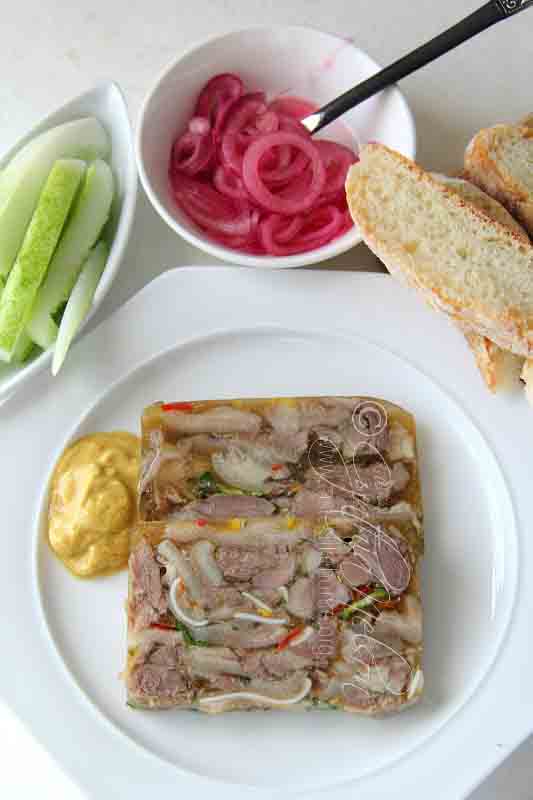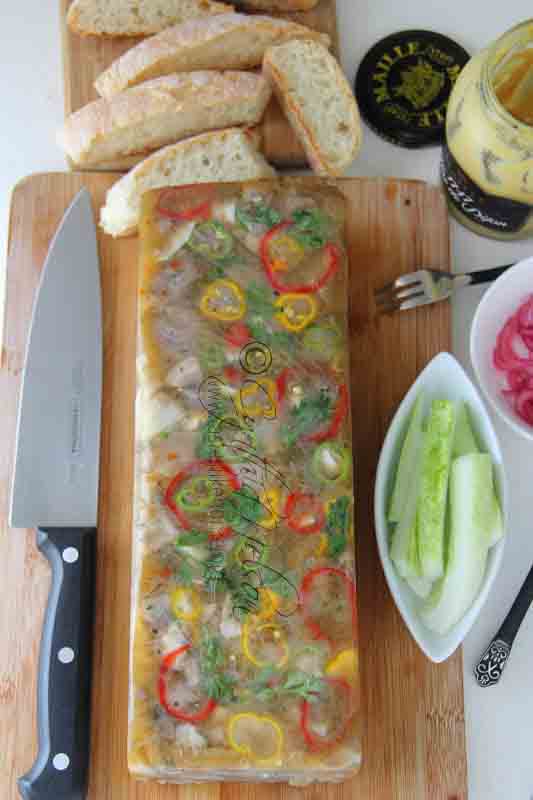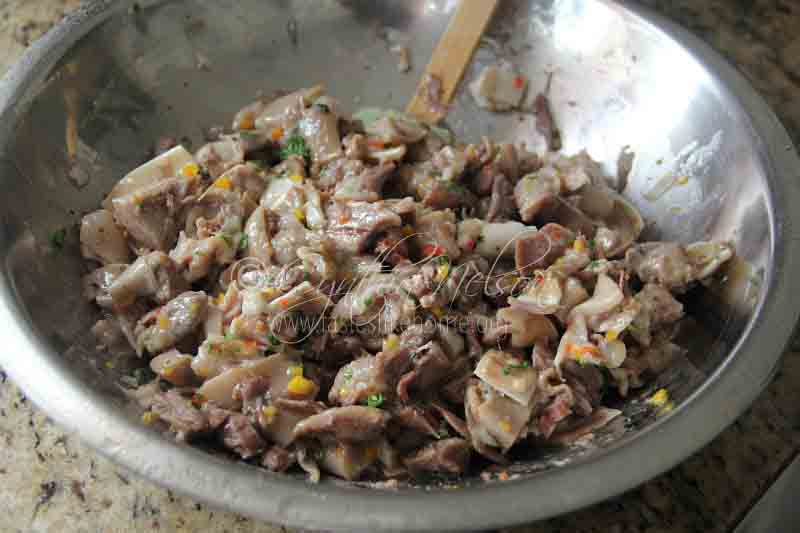Last week, in this 2-part series on eating a pig’s head, we looked at jowl bacon – bacon made from the cheeks of a pig. This week it is all about Head Cheese.
What is it?
Head Cheese also known as brawn is a cold cut; it is a terrine of meat jelly made with the flesh from the head of a pig. It can also be made with the head of a calf, cow, or sheep.
- Cold cut – slices of cold cooked or processed meats.
- Terrine – a meat, fish or vegetable mixture that has been cooked or otherwise prepared in advance and allowed to cool or set in a container.
What’s with the name – Head Cheese?
The ‘head’ in Head Cheese very practically refers to the part of the animal from which the dish is made, in this case, the head of a pig.

The ‘cheese’ in Head Cheese refers to the process of forming ingredients into loaves by pressing with weight and leaving them to set or chill. In the 17th century, it was known as ‘cheesing’. Cheese as we know it today was referred to as cheesed curds and the cooked pig’s head as cheesed head; today’s Head Cheese.
Where did it come from?
Head Cheese has deep roots in Europe, however, there are versions of Head Cheese that can be found in Latin America, North America, Asia, and even right here in the Caribbean. Our version is called souse; we pickle the meat instead of putting it in a mould to set and slice before serving.
Head Cheese, like Black Pudding, Cook-up Rice, Dirty Rice and many other dishes made from offal/odd bits and scraps, is a peasant dish.
How is it made?
I am glad you asked. It is easy to make, and you can remove the intimidation of confronting a pig’s head by getting your butcher to de-bone the head and cut it up into parts for you – ears, cheeks, snout (and tongue if you are using). In a nutshell what you will be doing is cooking the head meat in water with herbs, spices and aromatics, cutting up the cooked meat, and putting the lot into a pan along with some of the cooking liquid and leaving it to cool then refrigerating it so that it can congeal, making it easy to slice and serve. Let me break down the process for you.
MEAT
In addition to the ears, snout, cheeks and tongue if you are using, get a couple of the pig’s trotters (the feet). You need the trotters because there is a lot of collagen in the tendons, when this is cooked, it becomes natural gelatin, and this is what makes the Head Cheese congeal when it is cooled. There is collagen in the pig’s head too but a lot of is naturally occurring in the trotters/feet.
Wash the meat and pat dry.
SEASONING
It is very important that the meat be cooked in a flavoured liquid as this ultimately

determines the deliciousness of the Head Cheese and it is the main way to season the meat. Bay leaves, celery, thyme, carrots, onions, garlic, black peppercorns and allspice berries are the typical herb-spice-aromatic seasoning combo for Head Cheese. When I made mine, I put in a couple of scotch bonnets that I had pierced in a few places to add some heat to the broth.
Peel and halve the onions. Remove the paper skin from the bulb of garlic and simply halve the entire thing. Peel and cut the carrots in large chunks. Use the Chinese/Guyanese celery instead of the stalk celery; gives better flavour for this dish. A combination of fine and broadleaf thyme can be used. If using broadleaf thyme, leave it whole.
COOKING
A large stock pot with a lid has the capacity needed to cook the meat,
however, if you have a large pressure cooker, it makes the process quicker, the meat is done cooking in about 25 minutes. I cooked mine in a pressure cooker.
The meat of a pig’s head as well as the trotters are tough cuts of meat and need time to cook so that they can be broken down to release the naturally gelatin while simultaneously tenderizing the meat. In a regular pot, this can take up to 2 to 2 and 2½ hours. As I said above, a pressure cooker can do the job in 25 minutes. Choose which option works best for you.
Add everything to the pot – meat and seasonings, salt to taste and enough tap water to cover the meat.
Using a regular stock pot – cover pot, place over high heat and bring to a boil. Just before it comes to a boil, you will notice the froth on top, scoop it off and discard. Let the pot boil on high heat for 5 minutes, then reduce the heat to medium and cook until the meat is tender.
Using a pressure cooker – rest lid on top of pot (do not close). Just before it comes to a boil, remove the froth that forms on top and discard. Let the pot come a roaring boil then cover pressure cooker and set to pressure according your pressure cooker instructions. When the pot comes up to full pressure either by indication of whistle or consistent high hissing, let cook on high heat for 5 minutes then reduce heat to medium low and cook for 20 minutes. This is a different method of cooking so add less water to the pot, bring it up just two-thirds of the way up the meat.
● Remove the meat from the pot and rest in a bowl until cool to handle. Return the pot to the stove (with all the seasonings still in) with the heat on medium high and boil the liquid until it is reduced by more than a half – this is to concentrate the stock. Strain through a fine sieve and set aside. Taste for seasoning (salt) and adjust if necessary.
● Carefully separate the meat from the fat (discarding the fat), keep the skin and cartilage. Cut or separate the meat into chunks a little bigger than bite size. If you used the tongue, remove the outer skin before chopping the meat. Taste a piece of the meat for seasoning (salt); add a little if necessary, however, if the cooking liquid has in enough salt to taste, do not add more. Now at this stage, if you like, you can add some fresh, tender herbs like basil leaves, cilantro/coriander leaves or finely chopped parsley or seasoning peppers or decorative edible flowers to the mixture. These are all options and not necessary. I used chopped parsley, cilantro leaves and chopped seasoning peppers.
ASSEMBLING
If you have a terrine mould—an oblong-shaped dish use it—if not, a loaf pan will do. Line the pan with plastic wrap, this is so that you can easily remove the Head Cheese when it is formed. You can decorate the top of your Head Cheese by placing edible flowers, decoratively-cut herbs, sliced peppers or herb leaves, first, at the bottom of the lined pan. Remember the bottom will become the top when removed from the pan. Now spread the meat mixture evenly across the length and breadth of the pan. Pour in enough of the liquid to cover the meat. Take a dining knife and gently insert it in various parts of the meat to ensure that the liquid filters to the bottom. Let stand for 10 minutes and if you see it has absorbed the liquid, top it up with a little more of the liquid. You want to ensure that it is covered with liquid but not swimming in it.
Let the pan cool to room temperature and cover it with more plastic wrap (including the overhang). Let the plastic wrap rest directedly on the meat and liquid. Place the entire pan into the refrigerator to set; preferably overnight.
How to eat Head Cheese?
Remove the now solid loaf of Head Cheese from the pan and slice it thin or as thick as you like.
Head Cheese can be sliced and eaten as is, or it can be sandwiched between slices of bread or bread rolls. This cold cut goes well with an assortment of condiments such as mustard and pickles; dairy cheese and fruit too. I served mine with an apple salsa, pickled red onions, cucumbers, mustard and pepper sauce. If making sandwiches, other typical accompaniments such as lettuce and tomatoes are included; brush the bread or rolls with mayo before assembling the sandwich.
The Head Cheese can be served cold or at room temperature; I prefer cold. As soon as you are finished cutting/slicing, wrap the rest tightly in clean plastic wrap and then in aluminium foil and refrigerate; use within a week.
There are more than 2 ways to eat a pig’s head – you can slow roast it to yield crisp crackling, and you already know that the head is made into souse. It is not only the sum of its parts that is needed to make great tasting food, a pig’s snout, tongue, ears and cheeks, individually, make great tasting cured meats like bacon and guanciale, salt meat or when cooked fresh. Filipino Sigsig anyone? How about some pig’s ear salad? Do you want it crispy or soft?
Every now and then, we need to get out of our comfort zone and try something new. Let me know if you make the bacon or Head Cheese.
Cynthia


